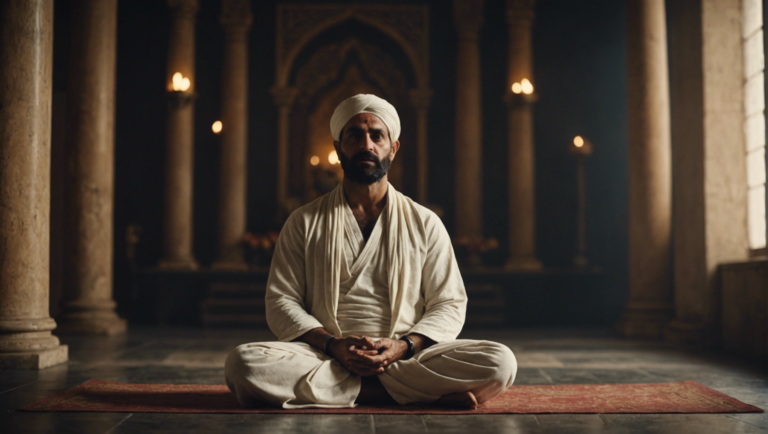Discovering The Origins: Where Is Kassandra Yoga From?
The Historical Roots of Kassandra Yoga
The quest to understand the roots and origins of various holistic practices often leads us on fascinating journeys through history and culture. Among these, the exploration of yoga’s diverse styles and contributions brings forth an intriguing narrative, particularly when delving into the specifics, such as Kassandra Yoga. This distinctive form, while not widely known in the classical sense, reflects a fascinating blend of tradition, innovation, and personal interpretation, warranting a deeper look into its background and how it fits into the broader yoga panorama.
Unveiling the Foundations of Kassandra Yoga
The essence of Kassandra Yoga finds its place not within ancient scriptures or traditional schools of yoga but rather as a contemporary interpretation that celebrates personal evolution within the practice. The modern yoga landscape is dotted with various adaptations and names, often derived from individuals who have contributed their unique perspectives and methodologies. In this light, Kassandra Yoga emerges as a modern derivative, named after a practitioner or teacher who has likely shaped the practice with personal insights and techniques that resonate with contemporary yogis.
Tracing the Influences and Inspirations
Kassandra Yoga, by its nature, draws from the vast well of yoga’s foundational principles while weaving in elements that speak to the individual journey of its namesake. This form of yoga, like many others born in the recent decades, might incorporate traditional asanas (poses), pranayama (breathing techniques), and dhyana (meditation), but tailored to fit the teachings and philosophies deemed most impactful by its creator.
The spectrum of yoga includes paths ranging from the physical focus of Hatha Yoga to the devotion-driven Bhakti Yoga, and the rigorous discipline of Ashtanga Yoga. Kassandra Yoga, according to its conceptual roots, could potentially bridge various elements from these traditional paths to form a holistic practice that emphasizes personal growth, flexibility (both physical and mental), and a deep connection with the self.
Contribution to the Modern Yoga Movement
The modern yoga movement is characterized by its inclusivity, innovation, and an ever-expanding definition of what yoga can be. In this evolving landscape, Kassandra Yoga contributes by offering an alternative for individuals seeking a practice that is both grounded in tradition and adaptable to individual needs and contexts. This approach reflects a broader trend within modern yoga of emphasizing accessibility, self-exploration, and therapeutic benefits, appealing to a wide audience that spans beyond the confines of conventional yoga studios or cultural origins.
The Core Philosophy and Practice
Central to Kassandra Yoga, like all yoga practices, is the commitment to unity between mind, body, and spirit. This unity is approached through a combination of physical postures, focused breathing, and meditative reflection, designed to promote health, relaxation, and a deeper sense of peace. What sets this practice apart is the emphasis on personal intuition and adaptation, encouraging practitioners to modify and shape their practice in a way that best supports their individual journey.
Practicing Kassandra Yoga, therefore, becomes an exercise in listening to one’s body, respecting its limits while gently pushing towards greater physical and mental wellbeing. This individual-centric approach empowers yogis to own their practice, making yoga a personally tailored experience rather than a one-size-fits-all regimen.
Looking Forward
As yoga continues to evolve and spread globally, the emergence of styles like Kassandra Yoga exemplifies the dynamic and adaptive nature of this ancient discipline. These modern interpretations keep the essence of yoga alive—adapting to new contexts and cultures while remaining rooted in the quest for self-awareness and holistic health. For those embarking on their yoga journey, exploring such variations offers a pathway to discovering a practice that resonates deeply with their personal goals and spiritual aspirations.
In the ever-evolving tapestry of yoga, contributions like Kassandra Yoga serve as reminders of the practice’s inherent flexibility and inclusivity. It underscores the idea that yoga, at its core, is a personal journey—one that molds to the contours of individual lives, histories, and aspirations. Through this lens, the study of Kassandra Yoga not only offers insight into a particular approach but also enriches our understanding of the broader, vibrant landscape of yoga today.
The Philosophical Foundations Underpinning Kassandra Yoga
At the heart of every yoga practice lies a core philosophy that not only enriches the physical aspect but enlivens the spiritual journey, inviting practitioners into a deeper understanding of themselves and the universe. Kassandra Yoga, with its unique blend of tradition and modernity, roots itself deeply in philosophical foundations that stretch back millennia, drawing inspiration from ancient texts and contemporary wisdom to guide its followers towards harmony, balance, and enlightenment.
Unveiling the Ancient Wisdom
One cannot discuss the essence of Kassandra Yoga without exploring the ancient teachings that form its backbone. This practice is heavily influenced by the principles outlined in the Yoga Sutras of Patanjali, a seminal text that dates back to over 2,000 years ago and remains a cornerstone in yoga philosophy. The text outlines the eight limbs of yoga, providing a roadmap for navigating the journey inward, leading practitioners towards Samadhi, or enlightenment.
Kassandra Yoga embraces these teachings, advocating for a balanced practice that encompasses all eight limbs. This approach ensures that individuals not only benefit physically through Asanas (postures) but also engage in a deeper spiritual exploration through Pranayama (breath control), Dhyana (meditation), and the ethical precepts of Yamas and Niyamas, promoting a lifestyle that is in harmony with the self and the environment.
Bridging Tradition and Modernity
In an era where the essence of yoga can sometimes get lost amid the commodification and Westernization of the practice, Kassandra Yoga stands as a beacon of authenticity, bridging the ancient with the contemporary. This form of yoga does not shy away from integrating modern scientific understanding with traditional insights, recognizing that the true spirit of yoga is timeless and transcends cultural boundaries.
The practice is tailored to meet the needs of today’s practitioners, offering techniques to combat modern stressors and ailments while staying true to the core philosophical tenets. It is this harmonious blend that attracts a diverse following, uniting individuals seeking physical wellness with those on a quest for spiritual growth.
Cultivating Mindfulness and Awareness
At its core, Kassandra Yoga places a significant emphasis on mindfulness and awareness, principles that are crucial in today’s fast-paced world. Through the practice, individuals are encouraged to foster an acute awareness of their body, mind, and emotions, leading to a heightened sense of presence and mindfulness. This focus not only improves physical health by promoting relaxation and reducing stress but also opens the door to greater self-awareness and self-understanding.
By engaging in Kassandra Yoga, practitioners embark on a journey of self-discovery, where each posture, breath, and meditation session becomes an act of mindfulness. This intentional practice leads to a profound transformation, where individuals can experience a sense of unity with the universe, transcending the illusion of separateness.
The Community Aspect
Beyond the individual, Kassandra Yoga emphasizes the importance of community and collective growth. Yoga, in its essence, is about connection — to oneself, to others, and to the universe at large. This philosophy underpins the practice, fostering a supportive environment where practitioners of all levels can come together to share, learn, and evolve.
In Kassandra Yoga classes, there’s a palpable sense of camaraderie and mutual respect, reflecting the teaching that we are all interconnected and that our actions, whether positive or negative, ripple outwards. This community aspect reinforces the philosophical teachings, making the practice not only a journey of personal development but also a pathway to contributing positively to the world around us.
Towards a Balanced Existence
In exploring the philosophical foundations underpinning Kassandra Yoga, one uncovers a rich tapestry of wisdom that guides practitioners towards a balanced, harmonious existence. It is a practice steeped in tradition yet fully engaged with the modern world, offering a holistic approach that nurtures the body, mind, and spirit. Through its teachings, individuals are equipped with the tools to navigate the complexities of life, embody mindfulness, and ultimately, step into their fullest potential.
Kassandra Yoga, with its profound philosophical roots, invites us all to delve deeper into our practice, encouraging us to explore not only the asanas but the rich spiritual landscape that yoga offers. It’s a journey of transformation, connection, and enlightenment, beckoning us to discover the infinite possibilities within.
Kassandra Yoga Today: A Global Phenomenon
Within the tapestry of modern wellness and fitness trends, a unique practice, originating from ancient traditions, has nestled itself into the hearts of millions worldwide. This phenomenon, though deeply rooted in historical lore, presents itself as a beacon of physical, mental, and spiritual rejuvenation in our contemporary society. Let’s delve into the essence and widespread allure of this practice, tracing its lineage and understanding its pivotal role in today’s global wellness landscape.
The Historical Backdrop and Global Emergence
The journey of yoga traces back thousands of years, anchored in the rich soils of ancient India. Initially a spiritual and ascetic discipline, yoga has evolved to encompass a wide array of practices, including physical postures (asanas), meditation (dhyana), and breath control (pranayama). This holistic practice aimed to unite the mind, body, and spirit, leading to enlightenment or ‘Moksha.’
As the wheels of time turned, the 20th century marked a pivotal moment for yoga, propelling it onto the global stage. Pioneers of the practice began to travel westward, sharing their knowledge and the transformative power of yoga with the rest of the world. Western practitioners adapted these teachings, blending them with their cultural contexts, leading to a proliferation of yoga schools and styles, each with its own focus and methodology.
The Rise of a Global Phenomenon
The surge in yoga’s popularity can be attributed to its accessibility and adaptability. This practice transcends age, fitness levels, and backgrounds, offering something unique to each individual. Whether one seeks physical health benefits, mental clarity, or a spiritual connection, yoga provides a personalized pathway. This universality has rendered it a global phenomenon, a common language of wellness spoken across continents.
Accessibility and Adaptability in the Digital Age
The advent of the digital age has further bulldozed barriers, making yoga more accessible than ever before. Online platforms, social media, and yoga apps have democratized access to yoga teachings, allowing novices and seasoned practitioners alike to explore various forms from the comfort of their homes. This digital proliferation has not only expanded yoga’s reach but also fostered a global community connected by a shared passion for holistic well-being.
The Impact on Health and Well-being
Numerous studies tout the health benefits of regular yoga practice. From improving flexibility and strength to enhancing cardiovascular health and reducing stress levels, the physical advantages are well-documented. Beyond the corporeal, yoga offers profound mental health benefits, acting as a potent antidote to the stresses of modern living. It encourages mindfulness, promotes better sleep patterns, and aids in managing anxiety and depression.
Yoga Today: A Reflection of Societal Shifts
Today’s incarnation of yoga mirrors broader societal shifts towards wellness, sustainability, and mindfulness. It stands at the intersection of ancient wisdom and modern science, continually evolving to meet the needs of its practitioners while staying true to its core principles. Global events, such as the COVID-19 pandemic, have underscored the importance of practices like yoga in maintaining physical health and emotional resilience in the face of adversity.
The Future Path
As we look towards the future, yoga’s trajectory appears to ascend further, propelled by a growing awareness of its multifaceted benefits. Innovations in virtual reality and augmented reality promise to deepen and enrich the practice, making immersive yoga experiences more widespread. Simultaneously, there’s a growing emphasis on yoga’s potential in healthcare, advocating for its integration into preventative and therapeutic medical practices.
The global phenomenon of yoga today stands as a testament to humanity’s enduring quest for balance, health, and connection. It is a vibrant, living tradition that continuously adapts, reflecting the changing times while holding steadfast to its ancient roots. As it stretches across borders and cultures, it weaves a tighter web of global unity, anchored in the pursuit of holistic well-being. In this sense, yoga is more than just a practice; it is a movement towards a more conscious, mindful, and harmonious world.
Core Practices and Techniques of Kassandra Yoga
Understanding the Philosophy Behind Kassandra Yoga
Kassandra Yoga stands as a beacon for those who seek a deeper understanding and connection with their body, mind, and spirit. This practice is more than just a series of poses; it’s a journey toward inner peace, enhanced mental clarity, and improved physical health. At its core, Kassandra Yoga intertwines ancient wisdom with contemporary practices, offering a holistic approach to wellness that caters to the modern individual’s needs.
Core Practices That Define Kassandra Yoga
Kassandra Yoga intertwines various techniques to form a comprehensive practice. Breathwork, or Pranayama, is foundational, guiding practitioners to connect with their inner rhythm and flow of energy. Through controlled breathing, individuals can enhance their focus, reduce stress, and tap into a profound sense of calm.
Meditation is another pillar, promoting mental clarity and mindfulness. Regular practice encourages a present state of mind, allowing individuals to detach from daily stresses and cultivate a deep sense of serenity and awareness.
Asana, or physical postures, are carefully selected and sequenced to improve flexibility, strength, and balance. These poses are not just physical exercises but are crafted to open and align the body’s energy channels, fostering a harmonious flow of Prana, or life force.
The integration of Chanting and Mantra repetition further enriches the practice, embedding spiritual dimensions within the physical routines. These sonic vibrations are believed to clear the mind, open the heart, and elevate the soul, connecting practitioners to the universal consciousness.
Yoga Nidra, or yogic sleep, is a transformative practice that guides individuals into a state of conscious relaxation. This technique is incredibly effective for stress reduction, emotional healing, and fostering a deep connection with the subconscious mind.
The Unique Techniques of Kassandra Yoga
Within Kassandra Yoga, unique techniques are introduced to enhance the traditional yoga practice. Dynamic movement sequences are combined with breathing exercises to create a meditative flow. This movement meditation helps in unlocking stagnant energy and rejuvenating the body and mind.
Another distinctive aspect is the emphasis on self-study or Svadhyaya. Practitioners are encouraged to explore personal growth and understanding through journaling, reading, and self-reflection. This practice not only deepens one’s yoga journey but also facilitates personal transformation.
Why Kassandra Yoga Resonates with Many
Kassandra Yoga resonates with a wide range of individuals due to its approachability and adaptability. Whether you’re a beginner or an experienced yogi, the practices and techniques can be modified to meet your unique needs and goals. Moreover, Kassandra Yoga emphasizes the importance of listening to one’s body and intuition, promoting a judgment-free and compassionate approach to personal growth and wellness.
Kassandra Yoga’s Contribution to Holistic Health
Kassandra Yoga contributes significantly to holistic health by addressing the physical, mental, and spiritual components of well-being. Its practices are designed not only to improve physical flexibility and strength but also to enhance emotional resilience and mental clarity. By fostering a deeper connection with oneself and the surrounding environment, Kassandra Yoga offers a path toward balanced and harmonious living.
Engaging with Kassandra Yoga: A Personal Journey
Engaging with Kassandra Yoga is like embarking on a personal journey of discovery and transformation. Each practice session is an opportunity to explore the depths of your being, to confront and release inner blockages, and to cultivate a sense of peace and fulfillment. As you delve deeper into the core practices and techniques, you’ll find not only improved health and well-being but also a greater alignment with your true self and life’s purpose.
Through a dedicated and mindful approach to Kassandra Yoga, individuals can experience profound changes, not just on the mat but in all aspects of their lives. This practice offers a pathway to discover the strength within, to navigate life’s challenges with grace, and to embrace a more connected and joyous existence.
The Transformative Effects of Kassandra Yoga on Practitioners
Yoga, with its ancient roots and varied practices, has evolved through millennia to adapt to the changing needs of its practitioners. Among the contemporary streams of this discipline, one that has gained notable attention for its profound impact on individuals is a lineage not widely known outside its fervent circle of followers: Kassandra Yoga. This form of yoga, named after its founder, integrates the traditional essence of yoga with modern insights into physical wellness and mental health, offering a holistic approach to personal transformation.
The Essence of Kassandra Yoga
Kassandra Yoga is more than a set of physical postures; it is a philosophy, a way of life. It emphasizes mindfulness, self-discovery, and the healing connection between the body and mind. Unlike more physically demanding styles of yoga, Kassandra Yoga focuses on gentle flows, breath control, and meditation, making it accessible to people of all ages and fitness levels. Practitioners often report a profound sense of peace and mental clarity, which they credit to the meditative aspects of this practice.
Physical Benefits That Resonate Beyond the Mat
The physical benefits of engaging in this yoga practice are both immediate and long-term. Participants notice an improvement in flexibility, muscle strength, and posture from the outset. However, the true transformation lies in the subtleties of the practice. Through consistent practice, individuals experience decreased levels of stress, lowered blood pressure, and an overall enhancement in their immune system functionality. Kassandra Yoga’s gentle approach also makes it an ideal rehabilitation path for those recovering from injuries, navigating the journey of healing with compassion and patience.
Mental and Emotional Transformation
Perhaps the most significant impact of Kassandra Yoga is on mental health. In a world fraught with stress, anxiety, and constant stimulation, this practice offers a sanctuary of calm. Regular practitioners report reduced levels of anxiety and depression, attributing these changes to the mindfulness and meditative practices embedded in Kassandra Yoga. The emphasis on living in the moment and cultivating a non-judgmental awareness of one’s thoughts and feelings leads to a deeper self-understanding and emotional resilience.
Fostering Community and Connection
Kassandra Yoga is not just a solitary practice; it thrives on community and connection. Classes often begin and end with sessions of sharing and reflection, allowing individuals to feel part of a supportive community. This sense of belonging and shared journey towards wellness amplifies the benefits of the practice, providing practitioners with a network of support and motivation.
Sustainable Practice for Environmental and Personal Wellbeing
In line with the holistic wellness approach, Kassandra Yoga also encourages sustainable living and environmental consciousness. Practitioners are often introduced to concepts of minimalism, ethical eating, and eco-friendly living as part of their yoga journey. This extension of yoga principles beyond the mat into everyday life choices fosters a deep sense of connection with the Earth and a personal commitment to living harmoniously within it.
The Path Forward with Kassandra Yoga
For those seeking a transformative practice that nourishes the body, calms the mind, and fosters a sense of community and environmental awareness, Kassandra Yoga offers a compelling path. Its gentle approach makes it accessible to beginners, while its profound mental and emotional benefits provide depth for advanced practitioners. As more individuals embark on this journey of self-discovery and holistic wellness, Kassandra Yoga continues to grow, enriching the tapestry of contemporary yoga practices with its unique blend of ancient wisdom and modern insight.
Conclusion
Delving into the essence of Kassandra Yoga unveils a rich tapestry of history, philosophy, and transformative practice that transcends boundaries and epochs. From its historical roots embedded in ancient traditions, Kassandra Yoga emerges as more than a mere set of exercises; it is a profound journey into the self, guided by centuries old wisdom and a deep connection to the universe. The philosophical underpinnings of Kassandra Yoga extend this exploration, offering practitioners a foundation built on principles of balance, harmony, and introspection.
As we survey the landscape of Kassandra Yoga today, its evolution into a global phenomenon is unmistakable. This global embrace is testament not only to the universal appeal of its teachings but also to the adaptability and relevance of Kassandra Yoga in addressing the needs of contemporary society. Its core practices and techniques, encompassing a wide range of physical postures, breathing exercises, and meditation techniques, are designed to cultivate strength, flexibility, and mental clarity. These practices, though rooted in ancient traditions, are remarkably pertinent to modern-day challenges, offering individuals a sanctuary from the stresses of daily life.
The transformative effects of Kassandra Yoga on practitioners are perhaps the most compelling testament to its enduring significance. Stories abound of individuals who have found in Kassandra Yoga a path to physical rejuvenation, emotional balance, and spiritual awakening. These personal transformations underscore the holistic nature of Kassandra Yoga, which seeks not just to improve physical health, but to enrich the practitioner’s life in every dimension.
Reflecting on the journey through the historical roots, philosophical foundations, contemporary global resonance, core practices, and transformative effects of Kassandra Yoga, one cannot help but be struck by the depth and breadth of this practice. Kassandra Yoga is more than a physical or spiritual discipline; it is a way of life that offers insights into how to live with greater awareness, balance, and harmony.
The enduring legacy and growing popularity of Kassandra Yoga speak volumes about its universal relevance and the profound impact it can have on individual lives. As we navigate an ever-changing world, the principles and practices of Kassandra Yoga provide a steadfast guide to cultivating a sense of inner peace, resilience, and connection to the wider universe.
To the uninitiated, Kassandra Yoga offers an inviting pathway to self-discovery and personal growth. For seasoned practitioners, it continues to offer deeper layers of understanding and a wellspring of renewal. The beauty of Kassandra Yoga lies in its ability to meet each practitioner where they are, offering a personalized journey towards holistic well-being.
The exploration of Kassandra Yoga is a reminder of the interconnectedness of body, mind, and spirit, and of the power of ancient wisdom to inform and enrich our modern lives. In the practices and teachings of Kassandra Yoga, we find timeless tools for living with grace and intention in a world teeming with distractions and challenges.
As Kassandra Yoga continues to spread across continents and cultures, it weaves a global community united by a shared pursuit of health, harmony, and enlightenment. This community, diverse in its composition but unified in its goals, stands as a beacon of hope for a future where wellness and mindfulness are paramount.
Embarking on or deepening one’s journey with Kassandra Yoga offers the promise not only of individual transformation but also of contributing to a collective shift towards a more conscious and connected world. The legacy of Kassandra Yoga is ongoing, its chapters written daily by those who practice and share its profound gifts. In this light, Kassandra Yoga is not just a historical or cultural artifact; it is a living, breathing guide for personal and collective evolution.




